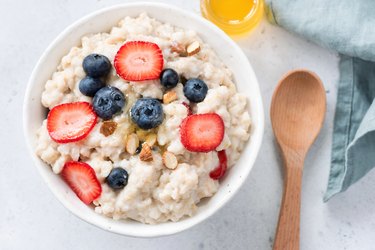
The glycemic index, or GI, ranks the effect of a carbohydrate-containing food on your blood glucose level on a scale of 1 to 100. The higher the GI, the more quickly a food can elevate your blood sugar. Oatmeal's glycemic index depends on how it's prepared.
Thanks to its soluble fiber content, a simple bowl of oatmeal offers plenty of sustained-release energy. Depending on the processing and preparation of the oats, oatmeal has a low to moderate effect on your blood glucose level and insulin production. According to Harvard Health Publishing, eating foods that score higher on the glycemic index scale can cause sharp increases in blood sugar levels.
Video of the Day
Video of the Day
Choosing foods that have a lower GI and eating foods that are high in soluble fiber — such as oatmeal — on a daily basis may help stabilize your blood sugar.
Tip
The oatmeal glycemic index varies based on how it's processed. Rolled oats' glycemic index is 59, whereas instant oats clock in at 83.
Read more: What Is the Nutritional Value of Oatmeal?
Oatmeal Glycemic Index
The GI of a grain product may vary according to the way the grain has been processed and prepared. According to the international GI database, maintained by the University of Sydney, a 250-gram serving of oatmeal — just about 9 ounces — has a GI of 58. A bowl of instant oatmeal, on the other hand, has a GI of 83.
The process of milling grains, such as oats or wheat, removes some of their fiber content, which accelerates digestion and raises the food's GI. If you want to reduce the GI of your oatmeal, avoid the instant varieties and try coarser, minimally processed oats.
Get Your Fiber
Oats' glycemic index is lower than that of other grains because they provide both soluble and insoluble fiber. Unlike insoluble plant fiber, which does not dissolve in water, soluble fiber absorbs water and turns viscous.
Rather than passing straight through the digestive system, foods with soluble fiber digest slowly, releasing the sugar content of a food at a gradual rate, according to the Harvard T.H. Chan School of Public Health.
Reap the Benefits
Slow carbs such as oatmeal provide a source of long-lasting energy. If you're trying to lose weight, oatmeal and other foods that are rich in soluble fiber will satisfy your hunger and help you avoid overeating.
For a low-GI breakfast that includes oatmeal, add a protein such as yogurt, milk or an egg. Because proteins and fats do not have an immediate effect on blood glucose levels, they do not have a rating on the glycemic index.
Read more: The 4 Best Instant Oatmeals (and 5 to Avoid)
Swap Flour for Oats
If you bake your own bread, you can lower its GI by replacing part of the wheat flour with oats. The soluble fiber in the oats will slow the digestion of the bread, reducing its effect on your blood sugar.
If you're used to a bowl of instant oatmeal in the morning, try steel-cut oats, which may take a few minutes longer to make, but have a heartier texture and a lower GI.